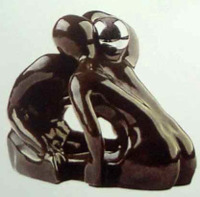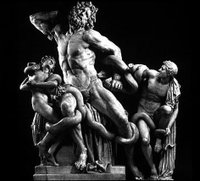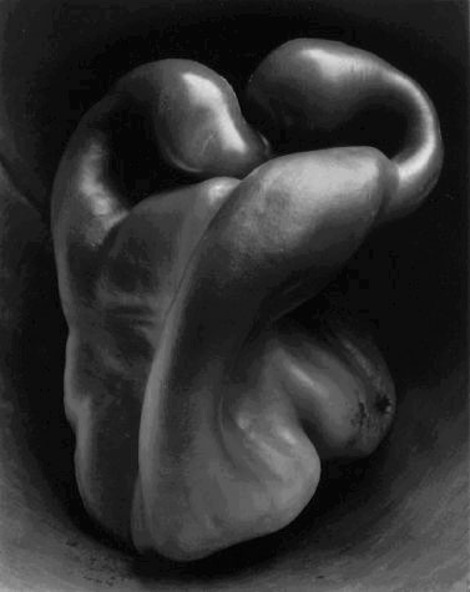The Equivalent
The idea was Alfred Stieglitz’s. Although Steiglitz suffered from logorrhea—compulsive soliloquizing, in his case—he gave the concept he derived from Symbolist art an elegant, simple name: an equivalent. In 1922, he claimed that his photographs were “equivalents” of his philosophy of life, and he famously titled a series of cloud photographs "Equivalents," firmly setting the idea into the vocabulary of photography. The term is simply the observation (or the assertion) that a picture of some specific thing can evoke other things altogether, in terms of feeling, meaning, associations, or form.
Stieglitz’s cloud pictures don’t measure up to their rap for yr. hmbl. critic. That is, they never much looked like anything but clouds to me, and many photographers—I think of Ralph Steiner first—have done better cloud pictures. But the idea of equivalence became a linchpin of expressive photography’s struggle against the medium’s insistent literalness and its often frustrating specificity.
On the surface, it might seem ironic that photography’s best-known example of Stieglitz’s idea would come from Edward Weston, since one of Weston’s stated allegiances was to “the thing itself.” Weston was one of the bohemian Californians who first mastered and then rejected art photography’s then-longstanding tradition of brooding, atmospheric vagueness. He used a hard-sharp “rectilinear” lens in place of the lovely soft-focus masterpieces so treasured by the pictorialists (revived today in Cooke’s modernization of the Pinkham and Smith), and turned to the workaday bromide papers that artists of the preceding era had conside red suitable mainly to newspaper darkrooms. If I recall my long-ago reading of Weston’s Daybooks (unfortunately I don’t have a set on hand to check), he shot Pepper No. 30 inside the open mouth of a metal funnel, and used a smaller aperture even than his little group’s namesake of ƒ/64—ƒ/128, using an exposure time of six hours. (I might be wrong about the numbers. It was something like that. And Weston might as well have been imprecise about it too: he was surely well into his slow film’s reciprocity failure by then, and five hours, or seven hours, would have served just as well.)
red suitable mainly to newspaper darkrooms. If I recall my long-ago reading of Weston’s Daybooks (unfortunately I don’t have a set on hand to check), he shot Pepper No. 30 inside the open mouth of a metal funnel, and used a smaller aperture even than his little group’s namesake of ƒ/64—ƒ/128, using an exposure time of six hours. (I might be wrong about the numbers. It was something like that. And Weston might as well have been imprecise about it too: he was surely well into his slow film’s reciprocity failure by then, and five hours, or seven hours, would have served just as well.)
In the past I’ve described Weston in Ezra Pound’s innovator-to-master progression (from The ABC of Reading, I think) as being most important neither for what he made of those who came before him nor how he influenced those who came after, but as a “great monolith” towering apart and unique in the adventure of photography’s early unfolding—important merely, and most impressively, in and of himself. He could see form in void, universality in specificity, arrangement in chaos, abstraction in hard reality, rarity in the common, beauty in decrepitude, and organic form everywhere, before anyone  had shown us the way. But whether he’s photographing deserts or kelp or women’s bodies or random debris, I understand him at the most basic level as a still-life photographer. His sensitivity to form and arrangement was supreme, and it resonates for us in a great many of his pictures—even when we’re not so aware of it as we are with this one.
had shown us the way. But whether he’s photographing deserts or kelp or women’s bodies or random debris, I understand him at the most basic level as a still-life photographer. His sensitivity to form and arrangement was supreme, and it resonates for us in a great many of his pictures—even when we’re not so aware of it as we are with this one.
In that sense it’s really not so much of a surprise after all that we so plainly see writhing in his quiet, still pepper, whether it evokes for us a struggle (cf. the Laocoön, right) or the grapple of lovers (cf. Monika Vasquez, The Embrace, bronze, above left). It is form that the still-life photographer brought to life, and that we respond to. It might even evoke things further into the reaches of the unconscious that are just as powerful…and just as far removed from a lone, somewhat deformed vegetable.
Because that’s one thing, at least, that this picture has never been about. Legend has it that after photographing it, Edward and his sons unceremoniously ate this most famous of all green bell peppers, in a salad.
___________________
A recent sale price for a vintage print: $130,700.00
Buy a real one (sort of) for a lot less than $130,000
A recommended essay by Chet Raymo
_________________
Copyright 2007 by Michael C. Johnston—All Rights Reserved
___________________
Support this site
Do you enjoy The Online Photographer? Any time you visit one of the following sites using the links below as a portal, we get a small commission for everything in any product category you might purchase during your visit, no matter how long you stay on their sites or how many pages you visit (and the prices are always the same to you either way). It's a nice and easy way to help enable T.O.P. to prosper while making your online purchases.




